The claw is a scythe-shaped appendage that is attached to the end bone of the toe. Cats have four toes on each hindfoot and five toes on the front feet. The fifth toe is the dewclaw, which is located on the inner side of the foot and does not make contact with the ground.
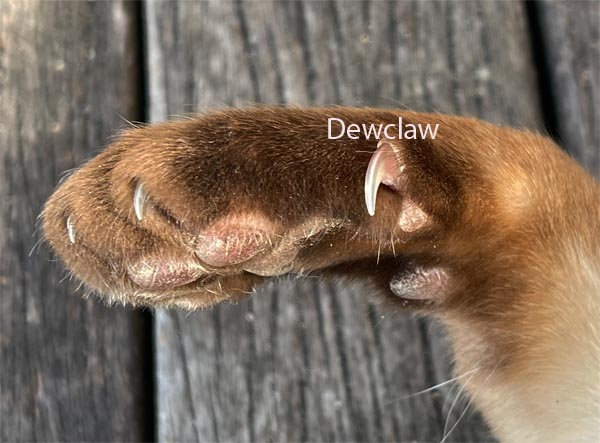
Some cats (known as polydactyls) have more than the normal number of toes and claws. Jake, an orange male from Ontario, Canada holds the world record for the largest number of toes at a whopping 28.
Function and anatomy of cat claws
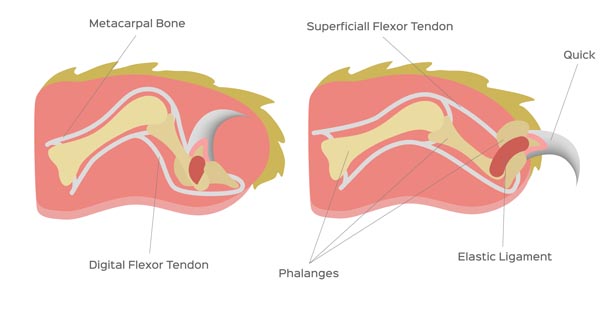
The claw (unguis) is located on the distal part of the toe and is attached to the final toe bone. Claws are composed of layers of keratinised (reinforced with keratin) dead cells. As the claw grows, the outer layer sheds which expose a sharp new claw underneath. Structures that produce the claw include the matrix, proximal nail fold (ungual fold), eponychium, paronychium and the hyponychium, which are collectively referred to as the perionychium.
The distal phalanx which contains the claw has two dorsal elastic ligaments which keep the claw retracted and sheathed within the skin of the paw which reduces wear and tear on the claws. To protract (extend) the claw, the cat uses the deep digital flexor muscle which overpowers the elasticity of the dorsal elastic ligaments.
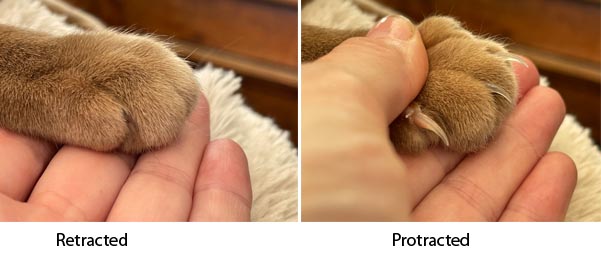
The quick is located in the centre of the cat’s claw and is rich in blood vessels to supply blood to help the claw grow and nerves.
Cat claw functions
The versatile claws play an important role in a number of functions.
- Climbing
- Balance
- Digging
- Traction
- Self-defence
- Gripping prey
- Scratching
Diseases and disorders that affect the claws

Cat claws are susceptible to damage and infection, and pet owners should routinely check the claws as a part of the monthly home check-up. Onycho or onych refers to the nail or claw and is commonly used when referring to claw disorders.
- Perionyxis: Inflammation of the epidermis surrounding the claw can be caused by pemphigus, an autoimmune disease that affects the skin, eyes, ears and toes of affected cats.
- Onychomadesis: Separation of the nail from the nail bed due to trauma, immune-mediated disease (pemphigus and systemic lupus erythematosus), infection, inadequate blood flow, cancer (melanoma, osteosarcoma, squamous cell carcinoma, eccrine carcinoma, subungual keratoacanthoma and inverted squamous papilloma).
- Onychodystrophy: Abnormal growth and deformed claws caused by acromegaly, congenital malformation and hyperthyroidism.
- Onychomycosis: Fungal infection of the nail bed, the most common pathogens are Malassezia and ringworm.
- Onychorrhexis: Brittle claws which are prone to breaking may be caused by infection or trauma.
- Paronychia: Inflammation or infection of the skin surrounding the claw which can be bacterial or fungal. Bacterial infections usually occur secondary to trauma, such as overzealous nail trimming, obsessive nail chewing, ingrown claws or declawing surgery. Other causes include systemic diseases such as FIV or FeLV, diabetes, systemic lupus erythematosus, Cushing’s disease and use of steroids.
- Onychocryptosis: Ingrown claws are common in older cats due to their reduced mobility.
- Onychauxis: A thickening of the claw associated with age, reduced exercise and grooming in senior cats exacerbate the problem.
- Trauma (tearing etc): Tears or damage to the claws most commonly occur due when the claw becomes snagged on something (carpet, material etc.), or when quickly scrambling up a tree, fence or more seriously, as the result of a motor vehicle accident.
Symptoms of claw disorders
Clinical signs of claw disorders can vary depending on the underlying condition but may include onychalgia (pain), lameness, reluctance to walk or jump, licking the affected claw, bleeding, swelling and an unpleasant odour.
Nail (claw) biting in cats

Many cats bite and chew their claws while they are grooming to remove the outer sheath from the claw. Cats maintain the claws of the front feet by scratching, however, they use their teeth to chew off the outer casings of the hind claws.
Nail-biting can become a compulsive behaviour in cats, just as it does in humans, but generally, it is just a normal part of their grooming routine. It is always a good idea to run such behaviours past your veterinarian.
Declawing
A procedure carried out in the US and Canada, declawing (onychectomy) is performed for non-medical reasons to prevent the cat from scratching furniture or family members (both pet and human).
It is often commonly assumed that declawing is the removal of the claw only (as the name suggests). However, it is a little more involved than that. Declawing includes the amputation of not only the claw and its germinative layers, but this extends up to the first knuckle.
Declawing is painful and psychologically damaging to the cat. Postoperative side-effects from declawing can be short-term and long term and include bleeding, infection, bone protrusion into the paw pad, lameness, behavioural problems such as biting and elimination problems.
Alternatives to declawing

There are several alternatives to declawing but the main goal is to prevent your cat from clawing and damaging furniture.
- Provide a cat tree/scratching post and work with the cat to encourage it to use that instead of your furniture. If space is a problem, you can buy small scratching posts that you hang over door handles that take up no room at all. Ideally, the scratching post should be 1.5 times taller than the cat is long. For more information on training your cat to use a scratching post, read here.
- Also known as Soft Claws, Soft Paws are soft vinyl nail caps glued over the top of the cat’s claws and act as a barrier between the cat’s claw and furniture to prevent damage.
- Trim the cat’s claws regularly, outdoor cats may naturally wear their claws down, however, indoor cats should have their claws trimmed once a month. Most cats dislike the feeling of having their paws touched, so it is always best that pet owners start trimming during kittenhood and make it an enjoyable experience using positive reinforcement such as offering the cat his or her favourite treats.
How to stop scratching
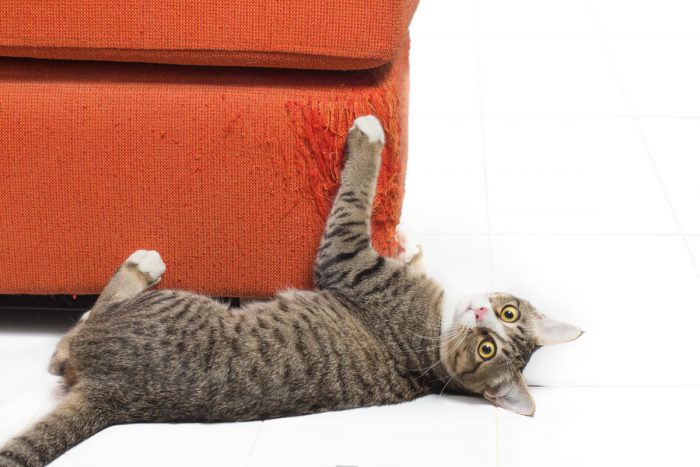
Scratching (stropping) is a natural behaviour and we should not expect our cat to stop doing so. When a cat scratches, they remove the loose outer layer of the claw, stretch their back and shoulder muscles, and exercise the retraction and protrusion apparatus. Scratching is also used in scent-marking as the paws contain scent glands on the undersides which are rubbed against the object they are scratching.
- Redirect the cat by making the current target unpleasant while providing your cat with a more attractive scratching post. There’s a huge variety of cat trees and scratching posts on the market which will suit all tastes and budgets. Carpet or sisal rope cover most cat trees. Look for a good-quality, sturdy post which will last longer than a cheap and flimsy cat tree.
- If possible, temporarily cover the object the cat is scratching with thick plastic to prevent further damage.
- Apply double-sided tape to affected areas, cats dislike the sticky feel of the tape.
- You can also try placing orange peel around the location. Many cats find the citrus smell extremely unpleasant.
- Encourage the cat to use the scratching post provided with the use of catnip spray applied to the post, or rub some dried catnip on the post. Cats enjoy a scratch after a nap, so try placing the scratching post close to your cat’s favoured sleeping location.
- If you see your cat making a beeline for a favourite piece of furniture to scratch on, gently pick up the cat and move it over to the scratching post. If the cat uses it heap plenty of praise on your cat. Cats respond far better to positive behaviour than negative behaviour from their owners.
- Cutting your cat’s claws regularly will minimise damage caused to your furniture.
- Never physically punish a cat when you catch it scratching inappropriately. Physical punishment serves no purpose and more often than not has a negative effect on how your cat perceives you.
With time and patience, you will be able to re-train your cat to use a more appropriate object than your furniture. Good luck!!!
Cat claw care

Just like human nails, the cat’s claws continually grow. Outdoor activities such as climbing and scratching help to wear down the claw. However, indoor cats don’t have as much opportunity for natural wear and tear, and it is especially important to keep the cat’s claws trimmed to avoid overgrown claws which can grow into the paw pad.
Regularly check the entire paw including the paw pads and the claws for signs of trauma, foreign bodies or infection.
How to trim a cat’s claws
Most cats only need to have the claws on the front paws trimmed. Outdoor cats usually wear their claws down naturally, but indoor cats don’t always have the opportunity to do so.
- Hold the cat in a comfortable position on your lap and gently squeeze the front paw between your thumb and index finger to protract the claws.
- Using ordinary nail clippers or pet claw clippers, snip the top 3-4 mm off the nail, avoiding the quick.
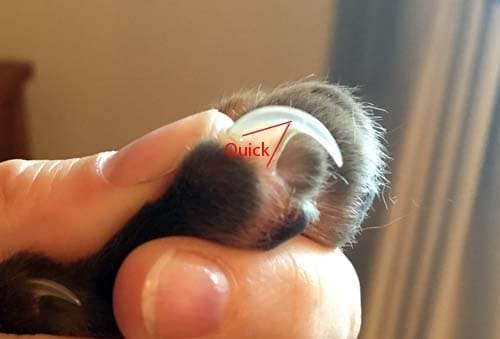

- If you accidentally cut the quick, apply styptic powder to stop the bleeding. If you don’t have these products, ordinary household flour or corn starch will do. Bleeding should stop within five minutes.
Frequently asked questions
Is it cruel to trim a cat’s claws?
No, trimming the claws is painless and helps to prevent overgrown claws.
What type of nail clippers should I use?
Human nail clippers are fine to use as long as they are sharp. Dull blades will crush the nail instead of cutting through it. Pet shops and veterinarians also sell nail trimmers for cats and dogs.
How often should I trim my cat’s claws?
This depends on the activity level of the cat, every 4-6 weeks is the average duration for nail trims.

